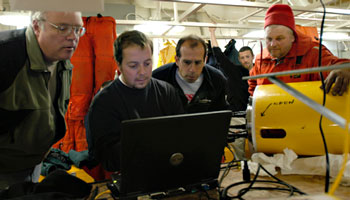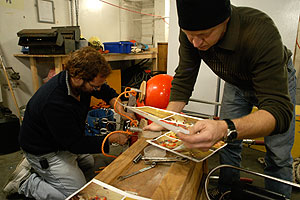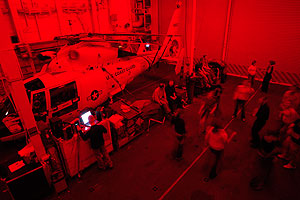|
|
 |
Daily Update
Calendar
Dispatch 18 - September 18, 2004
By C. A. Linder
Weather conditions: Overcast skies, calm winds and seas, air
temperature 37°F
For Ryan
This dispatch is dedicated to the memory of Ryan Schrawder, a member of our science party who died in a tragic motorcycle accident this spring. He would have been with us on the Healy this year, and we all miss him dearly. Not only was he a gifted technician, but he also had a heart of gold. Chief Scientist Bob Pickart also wanted to share these thoughts about Ryan.
"As we sailed from Barrow last year on the Healy there were a lot of questions on my mind regarding my mooring program. Number one was, did the profiling moorings survive the winter? The ability to have an instrument travel up and down large distances on a mooring wire is a young technology, and this particular type of profiler had never been used before. Furthermore, after recovering the instruments, we would have to turn them around at sea in a very short amount of time. I liken this to bringing a race car in for quick pit stop before sending it back out on the track for the next stretch. Up until now this had not been attempted with a moored profiler, but we had no choice because of our limited inventory of these instruments.
To help with these tasks we brought along a young technician from our deep-sea mooring group named Ryan Schrawder. I had not sailed with Ryan before, but he had been working with profilers for a while and had some expertise with them. Over the course of the next few weeks I got to see Ryan in action, and worked alongside him. In that short amount of time I gained a deep respect for his work ethic and skills, as well as his dedication and determination. He clearly wanted these profilers to succeed.
 |
 |
| Ryan extracts the moored profiler data for the first time, September 24, 2003. |
Click to enlarge
|
Ryan's first task was to help recover the instruments and find out if they worked. I'll never forget the excitement on his face (and my excitement as well) when we discovered that the first unit worked
almost perfectly. Then as we pulled up all 7 of them and discovered that each had returned nearly 100 percent data, our excitement turned to elation. But then the real challenge began. Working on a short time fuse Ryan had to open up each instrument and methodically revamp its components. This involved various trouble shooting as he discovered some hardware problems, and it meant making some difficult decisions. During this time I watched Ryan with increasing respect, realizing that he was an expert mechanic working on his set of "race cars." In just a few days time the instruments were back in the water, ready for round two.
During our short cruise on the Healy I also got to know Ryan as a person. As a fellow Red Sox fan we shared many anxious and happy moments as our team inched its way through the playoffs. I learned what a kind-hearted person Ryan was, and was thankful for his sense of humor and for keeping our spirits high during the long days of hard work. In his quiet and unassuming way he made an impression on many people in the science party and crew.
Ryan is not here now to see the fruits of his labor from last fall, but I know that he must be smiling. His race cars kept driving all year and we have another phenomenal data set on our hands. Ryan will be sorely missed, but in the years to come as I analyze these data I will be reminded constantly of his kind personality, and the lasting impact he had on this experiment."
Today we inched our way northward deeper into the Arctic. Yesterday's
winds have been replaced by a heavy enveloping
mist. Last year we saw ice at this location; this year the air
temperature is a balmy 37°F. As we collected data with the CTD, Jim
Johnson and David Roque Atienza assembled
a Canadian mooring for deployment. Anna Nikolopoulos also tested
a float that we will deploy if we find
a swirling eddy along the shelf edge.
 |
|
 |
| David Roque Atienza (left) and Jim Johnson assemble a mooring for a Canadian colleague. |
Saturday night fever in the helo hangar. |
| Click to enlarge | |
Click to enlarge
|
Tonight, the science party was let loose in
the kitchen, and we somehow managed to feed over a hundred people
for dinner (and clean up!). We have a new appreciation for the galley
crew's daily efforts. And, as a fitting end to our Saturday night,
a hoe-down was held in the helo hangar.
Seth Danielson played an incredible banjo
solo and DJ Jessie Cherry worked the music playlist from her laptop.
You'll find out more about the party tomorrow when I answer some questions
about shipboard entertainment.

|
Traducido al Español por
Mifaya
|
Para Ryan
Este comunicado esta dedicado a la memoria de Ryan Schrawder, un miembro de nuestro grupo de cientificos que murio en un tragico accidente de moto la primavera pasada. El hubiese estado en el Healy este ano con nosotros y nosotros le echamos de menos. No solo era un experto tecnico sino que tambien tenia un Corazon de oro. El jefe de los ceintificos, Bob Pickart, ha querido compartir unas pensamientos sobre Ryan.
“Mientras navegabamos el ano pasado en el Healy,habia un monton de preguntas en mi cabeza sobre mi programa de mooring. La numero uno era si los moorings sobrevivirian al invierno.La capacidad de que un instrumento se desplace verticalmete grandes distancias es una tecnologia muy reciente y este tipo de disposicion no se habia usado nunca.Ademas,una vez recuperados los moorings,tendriamos que devolverlos al mar en muy poco tiempo. Esto no se habia hecho nunca antes pero no teniamos otra oportunidad ya que careciamos de mas instrumentos.
Para ayudar con estas tareas tragimos a un joven tecnico de nuestro grupo de moorings de alta profundidad llamado Ryan Schrawder. Yo no habia navegado con Ryan antes, pero el habia estado trabajando con estos aparatos algun tiempo y tenia cierta experencia con ellos. Con el transcurso de las semanas le vi en accion y trabaje con el. En un corto periodo de tiempo le tome gran respeto por su etica de trabajo y por sus habilidades, asi como por su dedication y determinacion. El queria claramente que estos aparatos funcionasen.
La primera tarea de Ryan era recuperar los instrumentos y comprobar si funcionaban. Nunca olvidare la excitacion en su cara (y tambien la mia) cuando descubrimos que la primera unidad funcionaba casi perfectamente. Asi, cuando hubimos subido los 7 y descubierto que cada uno de ellos contenia casi el 100 por cien de los datos, nuestra excitacion se convirtio en autentica felcidad. Trabajando muy corto de tiempo, Ryan tuvo que abrir cada instrumento y cambiar los componentes. Esto condujo varios problemas graves ya que descubrimos que habia algunos problemas de hardware lo que significaba tener que tomar algunas deisiones dificiles.Durante ese tiempo,observe a Ryan con creceinte respeto, dandome cuenta de que era un experto mecanico trabajando con su escuadrilla de coches de carrera. En solo unos dias, los instrumentos estaban de vuelta en el agua, preparados para su segunda etapa.
Durante nuestro breve viaje en el Healy llegue a conocer a Ryan como persona. Como fervientes seguidores de los RedSox, compartimos muchos felices y ansiosos momentos ya que nuetro equipo entraba en los cuartos de final. Aprendi que era una persona de gran corazon y agradeci su sentido del humor y su afan por mantener nuestros espiritos altos durante los largos dias de duro trabajo. Con su tranquila e inusual forma de ser, causo impresion en muchas personas de la tripulacion.
Ryan no esta mas con nosotros para ver los frutos de su trabajo, pero se que debe estar sonriendo. Sus coches de carrera funcionaron todo el ano y tenemos otro fenomenal conjunto de datos en nuetras manos. Ryan sera anorado con toda seguridad, pero en los anos por venir, mientras analice los datos, estare recordando constantemente su agradable personalidad, y el impacto que tuvo en este experimento.”
Hoy nos hemos dirigido hacia el norte, hacia el Artico profundo. Los
vientos de ayer han sido remplazados por una
niebla espesa y envolvente. El ano pasdo vimos hielo en esta posicion
pero este ano la temperature es de 37 grados Farenhait. Mientras recogiamos
datos con la CTD, Jim Johnson y David Roque Atienza montaron un mooring
canadiense que sera lanzado. Anna Nikolopoulos tambien realizo pruebas
con un instrumento llamado float que sera lanzado si encontramos un
eddy en el limite de la plataforma continental.
El grupo de ceintificos en la cocina fue un exito ya que conseguimos cocinar para mas de cien personas y tambien limpiar! Asi tenemos una nueva perception de los esfuerzos diarios de la tripulacion encargada de la cocina. Y para terminar nuestra noche de Sabado tuvimos una fiesta tranquila en el angar de los helicopteros. Seth Danielson toco un incredible Solo con el banjo y DJ Jessie Cherry trabajo con la musica desde el portatil. Encontraras algo mas sobre la fiesta manana, cuando responda algunas cuestiones sobre diversion a bordo de un barco.
 Previous
Dispatch
Next Dispatch Previous
Dispatch
Next Dispatch

Back to Calendar
|
|




